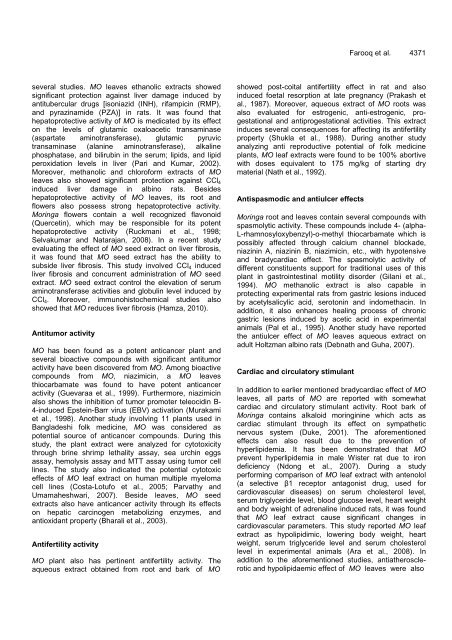Download Complete Issue (4740kb) - Academic Journals
Download Complete Issue (4740kb) - Academic Journals
Download Complete Issue (4740kb) - Academic Journals
Create successful ePaper yourself
Turn your PDF publications into a flip-book with our unique Google optimized e-Paper software.
several studies. MO leaves ethanolic extracts showed<br />
significant protection against liver damage induced by<br />
antitubercular drugs [isoniazid (INH), rifampicin (RMP),<br />
and pyrazinamide (PZA)] in rats. It was found that<br />
hepatoprotective activity of MO is medicated by its effect<br />
on the levels of glutamic oxaloacetic transaminase<br />
(aspartate aminotransferase), glutamic pyruvic<br />
transaminase (alanine aminotransferase), alkaline<br />
phosphatase, and bilirubin in the serum; lipids, and lipid<br />
peroxidation levels in liver (Pari and Kumar, 2002).<br />
Moreover, methanolic and chloroform extracts of MO<br />
leaves also showed significant protection against CCl4<br />
induced liver damage in albino rats. Besides<br />
hepatoprotective activity of MO leaves, its root and<br />
flowers also possess strong hepatoprotective activity.<br />
Moringa flowers contain a well recognized flavonoid<br />
(Quercetin), which may be responsible for its potent<br />
hepatoprotective activity (Ruckmani et al., 1998;<br />
Selvakumar and Natarajan, 2008). In a recent study<br />
evaluating the effect of MO seed extract on liver fibrosis,<br />
it was found that MO seed extract has the ability to<br />
subside liver fibrosis. This study involved CCl4 induced<br />
liver fibrosis and concurrent administration of MO seed<br />
extract. MO seed extract control the elevation of serum<br />
aminotransferase activities and globulin level induced by<br />
CCl4. Moreover, immunohistochemical studies also<br />
showed that MO reduces liver fibrosis (Hamza, 2010).<br />
Antitumor activity<br />
MO has been found as a potent anticancer plant and<br />
several bioactive compounds with significant antitumor<br />
activity have been discovered from MO. Among bioactive<br />
compounds from MO, niazimicin, a MO leaves<br />
thiocarbamate was found to have potent anticancer<br />
activity (Guevaraa et al., 1999). Furthermore, niazimicin<br />
also shows the inhibition of tumor promoter teleocidin B-<br />
4-induced Epstein-Barr virus (EBV) activation (Murakami<br />
et al., 1998). Another study involving 11 plants used in<br />
Bangladeshi folk medicine, MO was considered as<br />
potential source of anticancer compounds. During this<br />
study, the plant extract were analyzed for cytotoxicity<br />
through brine shrimp lethality assay, sea urchin eggs<br />
assay, hemolysis assay and MTT assay using tumor cell<br />
lines. The study also indicated the potential cytotoxic<br />
effects of MO leaf extract on human multiple myeloma<br />
cell lines (Costa-Lotufo et al., 2005; Parvathy and<br />
Umamaheshwari, 2007). Beside leaves, MO seed<br />
extracts also have anticancer activity through its effects<br />
on hepatic carcinogen metabolizing enzymes, and<br />
antioxidant property (Bharali et al., 2003).<br />
Antifertility activity<br />
MO plant also has pertinent antifertility activity. The<br />
aqueous extract obtained from root and bark of MO<br />
Farooq et al. 4371<br />
showed post-coital antifertility effect in rat and also<br />
induced foetal resorption at late pregnancy (Prakash et<br />
al., 1987). Moreover, aqueous extract of MO roots was<br />
also evaluated for estrogenic, anti-estrogenic, progestational<br />
and antiprogestational activities. This extract<br />
induces several consequences for affecting its antifertility<br />
property (Shukla et al., 1988). During another study<br />
analyzing anti reproductive potential of folk medicine<br />
plants, MO leaf extracts were found to be 100% abortive<br />
with doses equivalent to 175 mg/kg of starting dry<br />
material (Nath et al., 1992).<br />
Antispasmodic and antiulcer effects<br />
Moringa root and leaves contain several compounds with<br />
spasmolytic activity. These compounds include 4- (alpha-<br />
L-rhamnosyloxybenzyl)-o-methyl thiocarbamate which is<br />
possibly affected through calcium channel blockade,<br />
niazinin A, niazinin B, niazimicin, etc., with hypotensive<br />
and bradycardiac effect. The spasmolytic activity of<br />
different constituents support for traditional uses of this<br />
plant in gastrointestinal motility disorder (Gilani et al.,<br />
1994). MO methanolic extract is also capable in<br />
protecting experimental rats from gastric lesions induced<br />
by acetylsalicylic acid, serotonin and indomethacin. In<br />
addition, it also enhances healing process of chronic<br />
gastric lesions induced by acetic acid in experimental<br />
animals (Pal et al., 1995). Another study have reported<br />
the antiulcer effect of MO leaves aqueous extract on<br />
adult Holtzman albino rats (Debnath and Guha, 2007).<br />
Cardiac and circulatory stimulant<br />
In addition to earlier mentioned bradycardiac effect of MO<br />
leaves, all parts of MO are reported with somewhat<br />
cardiac and circulatory stimulant activity. Root bark of<br />
Moringa contains alkaloid moringinine which acts as<br />
cardiac stimulant through its effect on sympathetic<br />
nervous system (Duke, 2001). The aforementioned<br />
effects can also result due to the prevention of<br />
hyperlipidemia. It has been demonstrated that MO<br />
prevent hyperlipidemia in male Wister rat due to iron<br />
deficiency (Ndong et al., 2007). During a study<br />
performing comparison of MO leaf extract with antenolol<br />
(a selective β1 receptor antagonist drug, used for<br />
cardiovascular diseases) on serum cholesterol level,<br />
serum triglyceride level, blood glucose level, heart weight<br />
and body weight of adrenaline induced rats, it was found<br />
that MO leaf extract cause significant changes in<br />
cardiovascular parameters. This study reported MO leaf<br />
extract as hypolipidimic, lowering body weight, heart<br />
weight, serum triglyceride level and serum cholesterol<br />
level in experimental animals (Ara et al., 2008). In<br />
addition to the aforementioned studies, antiatherosclerotic<br />
and hypolipidaemic effect of MO leaves were also

















